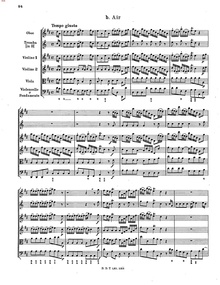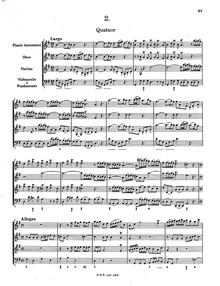Tafelmusik (Telemann)
Tafelmusik (the original title is Musique de table ) is a collection of instrumental works by the composer Georg Philipp Telemann (1681–1767) published in 1733 . The work is one of Telemann's best-known compositions; it is the climax and at the same time one of the last examples of courtly table music .
publication

Beginning of the 2nd movement of the overture to Part II. Handel included the opening stutti (up to bar 12) almost unchanged in his Organ Concerto Op. 7 No. 4 adopted.
|
The composition was aimed primarily at wealthy music lovers. The set of parts in the extensive work, engraved in copper, cost eight Reichstaler - an exorbitant price when you consider that Johann Sebastian Bach received the same amount to reward the entire orchestra, including timpani and trumpets, for courtly tribute music.
There were more than 200 subscribers who were willing to pay the purchase price in advance and whose name, location and place of residence were also published in the first edition. The illustrious list included not only crowned heads, noble ladies and merchants, but also musicians and composers from home and abroad - including Handel from London, Pisendel and Quantz from Dresden and Blavet from Paris.
Telemann, who was Hamburg's music director at the time of publication, rhymed about his publication:
- "Hopefully
this work will one day serve me to my glory, but you will never regret the fight ..."
Max Seiffert , musicologist, identified eighteen different quotations from table music in Handel's work - at the time, this was not considered plagiarism. On the contrary, Telemann felt flattered, especially since Handel reciprocated the favor by procuring rare plants from his old friend.
construction
The work is divided into three parts (“productions”) with the same structure: They begin with a large overture , followed by a quartet for three instruments and continuo , a concerto for several solo instruments and strings, a trio sonata and a solo sonata with continuo. The conclusion is formed by a sentence, which Telemann overwrites with Conclusion : He takes up the key and scoring of the introductory overture; Incidentally, the instrumentation and key do not follow any recognizable pattern.
With overture, concerto, trio and solo sonata as well as the quartet, which is otherwise rare in the Baroque but preferred by Telemann, each part offers an example of the most important instrumental genres.
Musique de table, 1st production
Overture (Suite) in E minor, TWV 55: e1
for two flutes, strings and continuo
- I. Overture: Lentement - Vite - Lentement
- II. Rejouissance
- III. rondeau
- IV. Loure
- V. Passepied
- VI. Air
- VII. Gigue
Quartet in G major, TWV 43: G2
for flute, oboe, violin and continuo
- I. Largo - Allegro - Largo
- II. Vivace - Moderato - Vivace
- III. Grave
- IV. Vivace
Concerto in A major, TWV 53: A2
for flute, violin, violoncello, strings and continuo
- I. Largo
- II. Allegro
- III. Grazioso
- IV. Allegro
Trio in E flat major, TWV 42: E flat 1
for two violins and continuo
- I. Affettuoso
- II. Vivace
- III. Grave
- IV. Allegro
Sonata in B minor, TWV 41: b4
for flute and continuo
- I. Cantabile
- II. Allegro
- III. Dolce
- IV. Allegro
Conclusion in E minor, TWV 50: 5
for two flutes, strings and continuo
- Sinfonia
Musique de table, 2nd production
Overture (Suite) in D major, TWV 55: D1
for oboe, trumpet, strings and continuo
- I. Overture
- II. Air: Tempo giusto
- III. Air: Vivace
- IV. Air: Presto
- V. Air: Allegro
Quartet in D minor, TWV 43: d1
for two flutes, recorder (or bassoon) and continuo
- I. Andante
- II. Vivace
- III. largo
- IV. Allegro
Concerto in F major, TWV 53: F1
for three violins, strings and continuo
- I. Allegro
- II. Largo
- III. Vivace
Trio in E minor, TWV 42: e2
for flute, oboe and continuo
- I. Affettuoso
- II. Allegro
- III. Dolce
- IV. Vivace
Sonata in A major, TWV 41: A4
for violin and continuo
- I. Andante
- II. Vivace
- III. Cantabile
- IV. Allegro - Adagio - Allegro - Adagio
Conclusion in D major, TWV 50: 9
for oboe, trumpet, strings and continuo
- Allegro - Adagio - Allegro
Musique de table, 3rd production
Overture (Suite) in B flat major, TWV 55: B1
for two oboes, bassoon, strings, continuo
- I. Overture
- II. Bergerie (un peu vivement)
- III. Allegresse (vite)
- IV. Postillons
- V. Flatery
- VI. Badinage (très vite)
- VII. Menuet
Quartet in E minor, TWV 43: e2
for flute, violin, violoncello and continuo
- I. Adagio
- II. Allegro
- III. Dolce
- IV. Allegro
Concerto in E flat major, TWV 54: E flat 1
for two horns, strings and continuo
- I. Maestoso
- II. Allegro
- III. Grave
- IV. Vivace
Trio in D major, TWV 42: D5
for two flutes and continuo
- I. Andante
- II. Allegro
- III. Grave - Largo - Grave
- IV. Vivace
Sonata in G minor, TWV 41: g6
for oboe and continuo
- I. Largo
- II. Presto: Tempo giusto
- III. Andante
- IV. Allegro
Conclusion in B flat major, TWV 50:10
for two oboes, bassoon, strings, continuo
- Furioso
Web links
- Tafelmusik : sheet music and audio files in the International Music Score Library Project (edition by Max Seiffert, Monuments of German Tonkunst)
